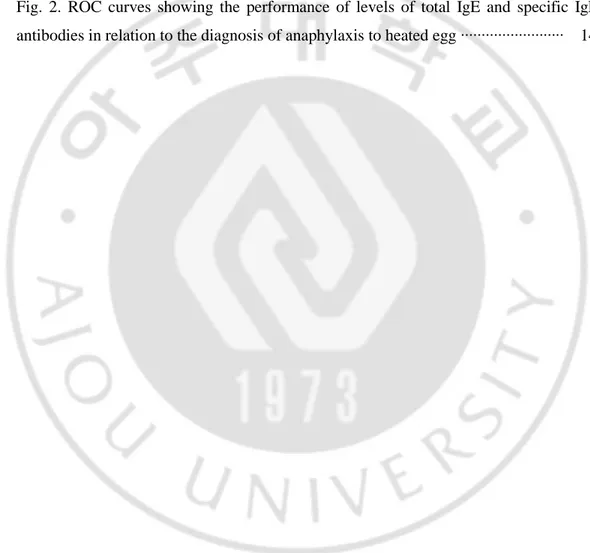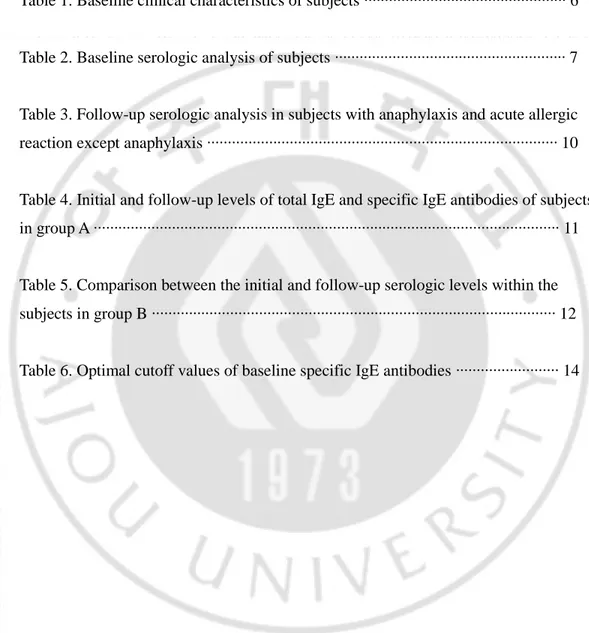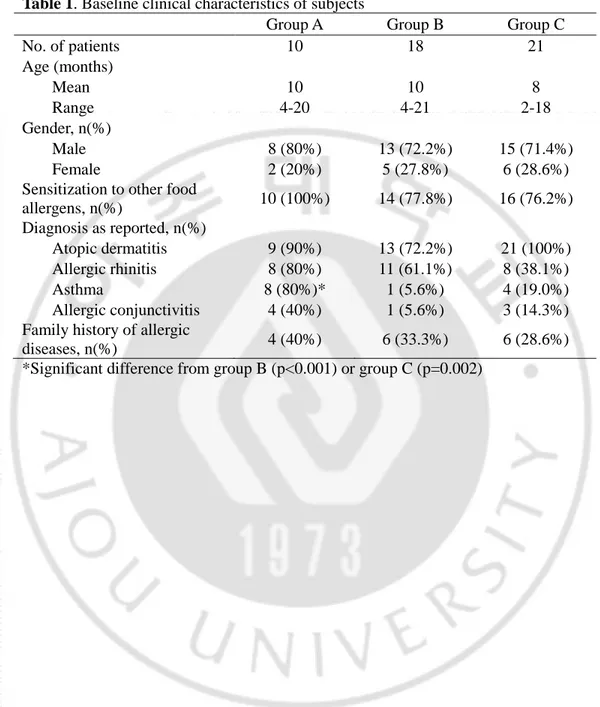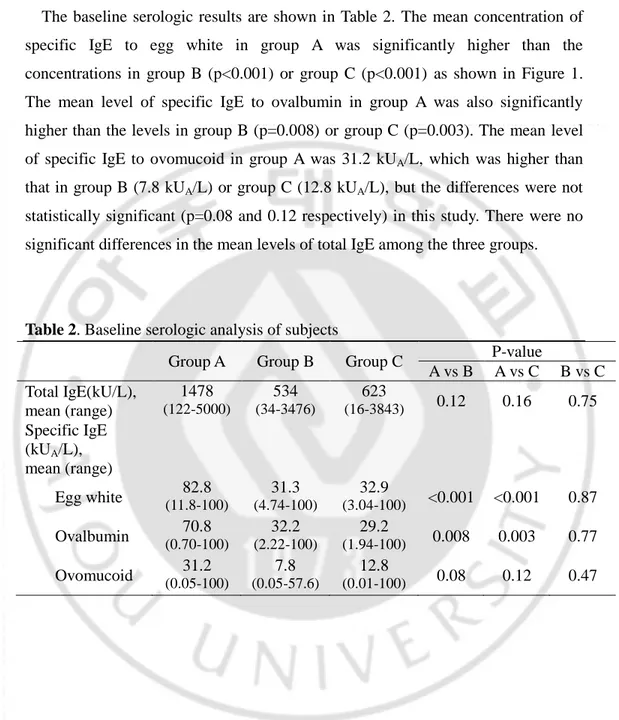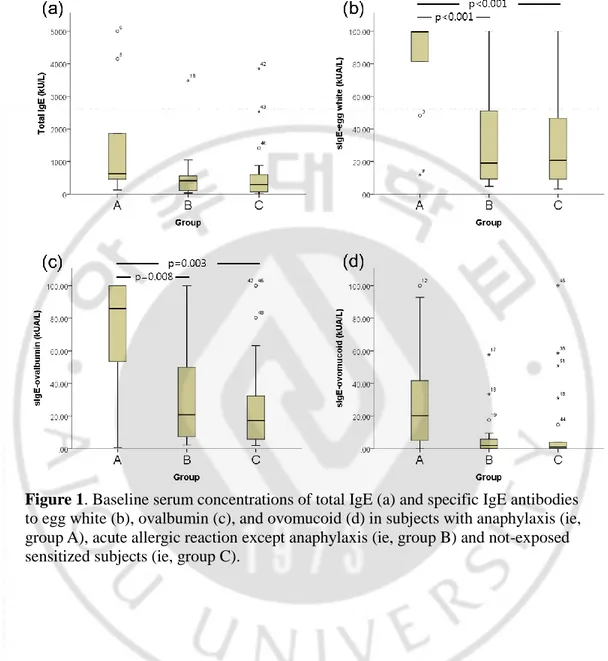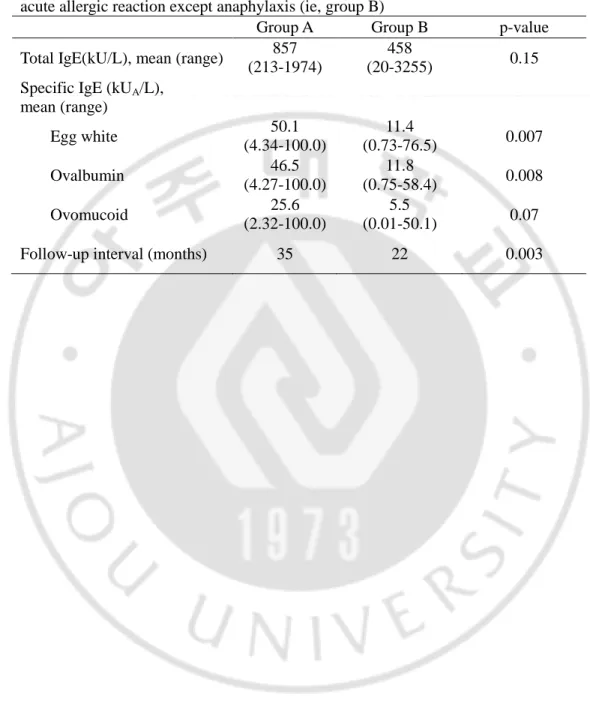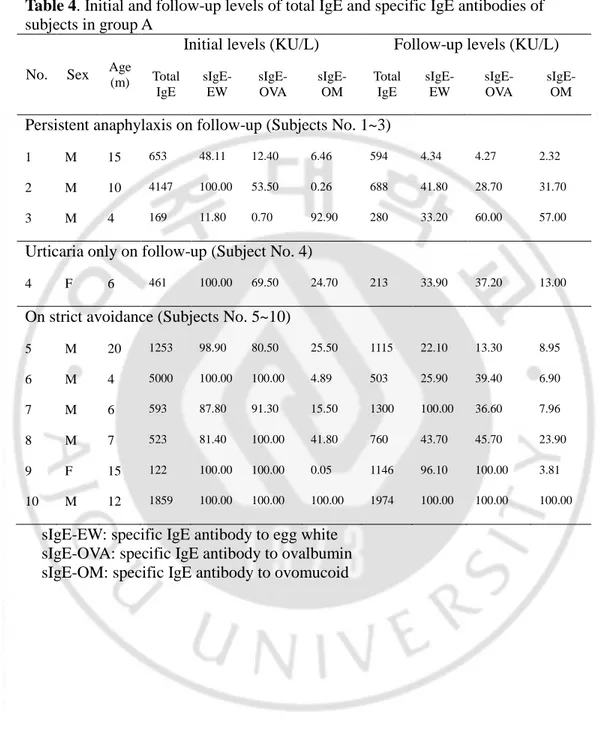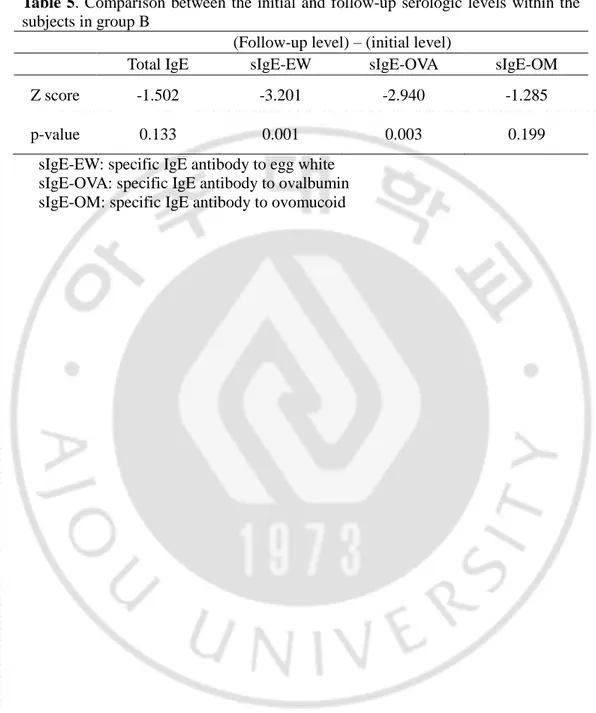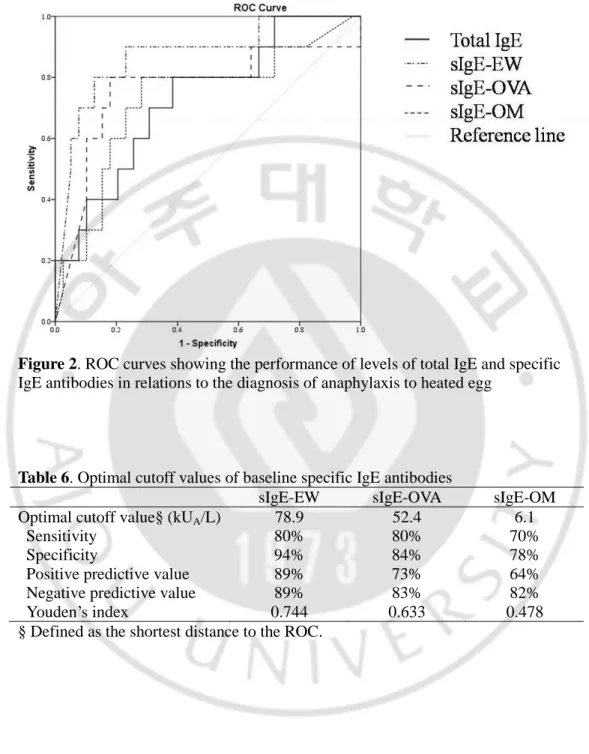저작자표시-비영리-변경금지 2.0 대한민국 이용자는 아래의 조건을 따르는 경우에 한하여 자유롭게 l 이 저작물을 복제, 배포, 전송, 전시, 공연 및 방송할 수 있습니다. 다음과 같은 조건을 따라야 합니다: l 귀하는, 이 저작물의 재이용이나 배포의 경우, 이 저작물에 적용된 이용허락조건 을 명확하게 나타내어야 합니다. l 저작권자로부터 별도의 허가를 받으면 이러한 조건들은 적용되지 않습니다. 저작권법에 따른 이용자의 권리는 위의 내용에 의하여 영향을 받지 않습니다. 이것은 이용허락규약(Legal Code)을 이해하기 쉽게 요약한 것입니다. Disclaimer 저작자표시. 귀하는 원저작자를 표시하여야 합니다. 비영리. 귀하는 이 저작물을 영리 목적으로 이용할 수 없습니다. 변경금지. 귀하는 이 저작물을 개작, 변형 또는 가공할 수 없습니다.
`
Clinical Significance of Specific IgE Antibody
Levels to Egg White, Ovalbumin and Ovomucoid
in Egg Allergic Children Under 24 Months
by
Kyung Uk Jeong
Major in Medicine
Department of Medical Sciences
The Graduate School, Ajou University
`
Clinical Significance of Specific IgE Antibody
Levels to Egg White, Ovalbumin and Ovomucoid
in Egg Allergic Children Under 24 Months
by
Kyung Uk Jeong
A Dissertation Submitted to The Graduate School of
Ajou University in Partial Fulfillment of The Requirements
for The Degree of Master of Medicine
Supervised by
Soo Young Lee, M.D., Ph.D.
Major in Medicine
Department of Medical Sciences
The Graduate School, Ajou University
`
This certifies that the dissertation
of Kyung Uk Jeong is approved.
SUPERVISORY COMMITTEE
Soo Young Lee
Moon Sung Park
Jun Eun Park
The Graduate School, Ajou University
June 20th, 2014
i
- ABSTRACT-
Clinical Significance of Specific IgE Antibody Levels
to Egg White, Ovalbumin and Ovomucoid
in Egg Allergic Children Under 24 Months
Objectives: Egg allergy is one of the most common food allergies in children. Specific
IgE antibodies to egg white is associated with the outcome of oral challenge tests, and specific IgE antibodies to ovomucoid have been suggested as prognostic factors of clinical tolerance to heated egg in children with egg allergy. The aim of this study was to firstly to assess the diagnostic value and optimal cutoff levels of baseline specific IgE antibodies to egg white, ovalbumin, and ovomucoid in predicting anaphylaxis, and secondly to evaluate the clinical usefulness of the specific IgE antibodies in predicting persistence of immediate-type allergic reactions in young children.
Methods: This study included 49 children younger than 24 months of age who visited
the Pediatric Allergy Clinic of Ajou University Hospital from January 2008 to September 2013 and had undergone measurements of specific IgE antibodies to egg white by means of ImmunoCAP at least twice. Group A was composed of 10 children who had a history of anaphylaxis after ingestion of heated egg. Group B was composed of 18 children who had experienced non-anaphylactic allergic reactions after ingestion of heated egg. Group C was the not-exposed-sensitization group. Baseline concentrations of total IgE as well as specific IgE antibodies to egg white, ovalbumin, and ovomucoid were quantified and compared between groups. For subjects in group A and B, follow-up measurements of specific IgE antibodies to ovalbumin and ovomucoid were done.
Results: The mean age of subjects was 9.4 months. There were no significant
ii
allergens and family history of allergic diseases between groups. The percentages of diagnosed atopic dermatitis, allergic rhinitis and allergic conjunctivitis did not show significant differences between groups, but the percentage of diagnosed asthma was significantly higher in group A than group B (p<0.001) or group C (p=0.002). Children with a history of anaphylaxis after ingestion of heated egg had considerably higher baseline levels of specific IgE antibodies to egg white (p<0.001)as well as significantly higher levels of specific IgE antibodies to ovalbumin (p=0.008) than children who had non-anaphylactic allergic reactions to heated egg. The baseline level of specific IgE antibodies to ovomucoid was higher in group A (mean±SD 31.2±36.8 kU/L) than group B (7.8±15.0 kU/L) but the difference was not statistically significant (p=0.08). On follow-up assessment after the mean interval of 22 months, all 18 subjects in group B had outgrown their egg allergy and had significantly lower levels of specific IgE to egg white (p=0.001) and ovalbumin (p=0.003) than the baseline levels. The follow-up concentration of specific IgE antibodies to ovomucoid was not significantly lower than the baseline concentration (p=0.199). Receiver operating characteristic analysis showed that specific IgE antibodies to egg white were more useful than specific IgE antibodies to ovalbumin or ovomucoid for the diagnosis of anaphylaxis in young children with egg allergy. The optimal cutoff point 78.9 kUA/L for specific IgE antibodies to egg white resulted in a clinical sensitivity of 80% and a specificity of 94%.
Conclusion: Baseline concentration of specific IgE antibodies to egg white was a more
useful marker than specific IgE antibodies to ovalbumin or ovomucoid, in predicting anaphylaxis in young children with egg allergy. Comparison between baseline and follow-up concentrations of specific IgE antibodies to egg white and ovalbumin was useful in predicting persistence of immediate-type allergic reactions to heated egg.
iii
TABLE OF CONTENTS
ABSTRACT ∙∙∙∙∙∙∙∙∙∙∙∙∙∙∙∙∙∙∙∙∙∙∙∙∙∙∙∙∙∙∙∙∙∙∙∙∙∙∙∙∙∙∙∙∙∙∙∙∙∙∙∙∙∙∙∙∙∙∙∙∙∙∙∙∙∙∙∙∙∙∙∙∙∙∙∙∙∙∙∙∙∙∙∙∙∙∙∙∙∙∙∙∙∙∙∙∙∙∙∙∙∙∙∙∙∙∙∙ i TABLE OF CONTENTS ∙∙∙∙∙∙∙∙∙∙∙∙∙∙∙∙∙∙∙∙∙∙∙∙∙∙∙∙∙∙∙∙∙∙∙∙∙∙∙∙∙∙∙∙∙∙∙∙∙∙∙∙∙∙∙∙∙∙∙∙∙∙∙∙∙∙∙∙∙∙∙∙∙∙∙∙∙∙∙∙∙∙∙∙∙∙∙ iii LIST OF FIGURES ∙∙∙∙∙∙∙∙∙∙∙∙∙∙∙∙∙∙∙∙∙∙∙∙∙∙∙∙∙∙∙∙∙∙∙∙∙∙∙∙∙∙∙∙∙∙∙∙∙∙∙∙∙∙∙∙∙∙∙∙∙∙∙∙∙∙∙∙∙∙∙∙∙∙∙∙∙∙∙∙∙∙∙∙∙∙∙∙∙∙∙∙∙∙∙ iv LIST OF TABLES ∙∙∙∙∙∙∙∙∙∙∙∙∙∙∙∙∙∙∙∙∙∙∙∙∙∙∙∙∙∙∙∙∙∙∙∙∙∙∙∙∙∙∙∙∙∙∙∙∙∙∙∙∙∙∙∙∙∙∙∙∙∙∙∙∙∙∙∙∙∙∙∙∙∙∙∙∙∙∙∙∙∙∙∙∙∙∙∙∙∙∙∙∙∙∙∙∙ v
Ⅰ. INTRODUCTION ∙∙∙∙∙∙∙∙∙∙∙∙∙∙∙∙∙∙∙∙∙∙∙∙∙∙∙∙∙∙∙∙∙∙∙∙∙∙∙∙∙∙∙∙∙∙∙∙∙∙∙∙∙∙∙∙∙∙∙∙∙∙∙∙∙∙∙∙∙∙∙∙∙∙∙∙∙∙∙∙∙∙∙∙∙∙∙∙∙∙ 1 Ⅱ. METHOD ∙∙∙∙∙∙∙∙∙∙∙∙∙∙∙∙∙∙∙∙∙∙∙∙∙∙∙∙∙∙∙∙∙∙∙∙∙∙∙∙∙∙∙∙∙∙∙∙∙∙∙∙∙∙∙∙∙∙∙∙∙∙∙∙∙∙∙∙∙∙∙∙∙∙∙∙∙∙∙∙∙∙∙∙∙∙∙∙∙∙∙∙∙∙∙∙∙∙∙∙∙∙∙ 3 A. Subjects ∙∙∙∙∙∙∙∙∙∙∙∙∙∙∙∙∙∙∙∙∙∙∙∙∙∙∙∙∙∙∙∙∙∙∙∙∙∙∙∙∙∙∙∙∙∙∙∙∙∙∙∙∙∙∙∙∙∙∙∙∙∙∙∙∙∙∙∙∙∙∙∙∙∙∙∙∙∙∙∙∙∙∙∙∙∙∙∙∙∙∙∙∙∙∙∙∙∙∙∙∙∙∙ 3 B. Measurement of the total IgE and specific IgE antibody levels ∙∙∙∙∙∙∙∙∙∙∙∙∙∙∙∙∙ 3 C. Statistical Analysis ∙∙∙∙∙∙∙∙∙∙∙∙∙∙∙∙∙∙∙∙∙∙∙∙∙∙∙∙∙∙∙∙∙∙∙∙∙∙∙∙∙∙∙∙∙∙∙∙∙∙∙∙∙∙∙∙∙∙∙∙∙∙∙∙∙∙∙∙∙∙∙∙∙∙∙∙∙∙∙∙∙∙∙∙∙∙ 4 Ⅲ. RESULT ∙∙∙∙∙∙∙∙∙∙∙∙∙∙∙∙∙∙∙∙∙∙∙∙∙∙∙∙∙∙∙∙∙∙∙∙∙∙∙∙∙∙∙∙∙∙∙∙∙∙∙∙∙∙∙∙∙∙∙∙∙∙∙∙∙∙∙∙∙∙∙∙∙∙∙∙∙∙∙∙∙∙∙∙∙∙∙∙∙∙∙∙∙∙∙∙∙∙∙∙∙∙∙∙∙ 5 Ⅳ. DISCUSSION ∙∙∙∙∙∙∙∙∙∙∙∙∙∙∙∙∙∙∙∙∙∙∙∙∙∙∙∙∙∙∙∙∙∙∙∙∙∙∙∙∙∙∙∙∙∙∙∙∙∙∙∙∙∙∙∙∙∙∙∙∙∙∙∙∙∙∙∙∙∙∙∙∙∙∙∙∙∙∙∙∙∙∙∙∙∙∙∙∙∙∙∙∙∙∙ 15 Ⅴ. CONCLUSION ∙∙∙∙∙∙∙∙∙∙∙∙∙∙∙∙∙∙∙∙∙∙∙∙∙∙∙∙∙∙∙∙∙∙∙∙∙∙∙∙∙∙∙∙∙∙∙∙∙∙∙∙∙∙∙∙∙∙∙∙∙∙∙∙∙∙∙∙∙∙∙∙∙∙∙∙∙∙∙∙∙∙∙∙∙∙∙∙∙∙∙∙∙ 19 REFERENCES ∙∙∙∙∙∙∙∙∙∙∙∙∙∙∙∙∙∙∙∙∙∙∙∙∙∙∙∙∙∙∙∙∙∙∙∙∙∙∙∙∙∙∙∙∙∙∙∙∙∙∙∙∙∙∙∙∙∙∙∙∙∙∙∙∙∙∙∙∙∙∙∙∙∙∙∙∙∙∙∙∙∙∙∙∙∙∙∙∙∙∙∙∙∙∙∙∙∙∙∙∙ 20 국문요약∙∙∙∙∙∙∙∙∙∙∙∙∙∙∙∙∙∙∙∙∙∙∙∙∙∙∙∙∙∙∙∙∙∙∙∙∙∙∙∙∙∙∙∙∙∙∙∙∙∙∙∙∙∙∙∙∙∙∙∙∙∙∙∙∙∙∙∙∙∙∙∙∙∙∙∙∙∙∙∙∙∙∙∙∙∙∙∙∙∙∙∙∙∙∙∙∙∙∙∙∙∙∙∙∙∙∙∙∙∙∙∙ 23
iv
LIST OF FIGURES
Fig. 1. Baseline serum concentrations of total IgE and specific IgE antibodies to egg white, ovalbumin, and ovomucoid ∙∙∙∙∙∙∙∙∙∙∙∙∙∙∙∙∙∙∙∙∙∙∙∙∙∙∙∙∙∙∙∙∙∙∙∙∙∙∙∙∙∙∙∙∙∙∙∙∙∙∙∙∙∙∙∙∙∙∙∙∙∙∙∙∙∙∙∙∙∙∙∙∙∙∙∙∙∙∙ 8
Fig. 2. ROC curves showing the performance of levels of total IgE and specific IgE antibodies in relation to the diagnosis of anaphylaxis to heated egg ∙∙∙∙∙∙∙∙∙∙∙∙∙∙∙∙∙∙∙∙∙∙∙∙∙ 14
v
LIST OF TABLES
Table 1. Baseline clinical characteristics of subjects ∙∙∙∙∙∙∙∙∙∙∙∙∙∙∙∙∙∙∙∙∙∙∙∙∙∙∙∙∙∙∙∙∙∙∙∙∙∙∙∙∙∙∙∙∙∙∙∙∙ 6
Table 2. Baseline serologic analysis of subjects ∙∙∙∙∙∙∙∙∙∙∙∙∙∙∙∙∙∙∙∙∙∙∙∙∙∙∙∙∙∙∙∙∙∙∙∙∙∙∙∙∙∙∙∙∙∙∙∙∙∙∙∙∙∙∙∙ 7
Table 3. Follow-up serologic analysis in subjects with anaphylaxis and acute allergic reaction except anaphylaxis ∙∙∙∙∙∙∙∙∙∙∙∙∙∙∙∙∙∙∙∙∙∙∙∙∙∙∙∙∙∙∙∙∙∙∙∙∙∙∙∙∙∙∙∙∙∙∙∙∙∙∙∙∙∙∙∙∙∙∙∙∙∙∙∙∙∙∙∙∙∙∙∙∙∙∙∙∙∙∙∙∙∙∙∙∙ 10
Table 4. Initial and follow-up levels of total IgE and specific IgE antibodies of subjects in group A ∙∙∙∙∙∙∙∙∙∙∙∙∙∙∙∙∙∙∙∙∙∙∙∙∙∙∙∙∙∙∙∙∙∙∙∙∙∙∙∙∙∙∙∙∙∙∙∙∙∙∙∙∙∙∙∙∙∙∙∙∙∙∙∙∙∙∙∙∙∙∙∙∙∙∙∙∙∙∙∙∙∙∙∙∙∙∙∙∙∙∙∙∙∙∙∙∙∙∙∙∙∙∙∙∙∙∙∙∙∙∙∙∙ 11
Table 5. Comparison between the initial and follow-up serologic levels within the subjects in group B ∙∙∙∙∙∙∙∙∙∙∙∙∙∙∙∙∙∙∙∙∙∙∙∙∙∙∙∙∙∙∙∙∙∙∙∙∙∙∙∙∙∙∙∙∙∙∙∙∙∙∙∙∙∙∙∙∙∙∙∙∙∙∙∙∙∙∙∙∙∙∙∙∙∙∙∙∙∙∙∙∙∙∙∙∙∙∙∙∙∙∙∙∙∙∙∙∙∙ 12
1
INTRODUCTION
Egg allergy is one of the most common food allergies in infants and young children (Eggesbo et al., 2001). The prevalence of egg allergy is estimated to be between 3% and 7% at the age of 2 years (Eggesbo et al., 1999) and is considerably higher, up to 30%, in children with atopic dermatitis and other food allergies (Sampson and McCaskill, 1985). Although egg allergy usually outgrows with age, it can persist beyond the age of 5 years (Savage et al., 2007). Reactions to egg can vary from urticaria to life-threatening systemic responses such as anaphylaxis (Hill and Hosking, 2004), and it is important to confirm the diagnosis of an egg allergy as the elimination of eggs from the diet is essential for patients who had experienced severe systemic allergic reactions. As the levels of specific IgE antibodies to egg white have been shown to be correlated with the outcome of oral challenge tests (Komata et al., 2007), the predictive decision points for specific IgE antibodies to egg white are widely used in clinical settings (Sampson, 2004; Caubet and Wang, 2011). However, some patients with the levels of specific IgE antibodies higher than the predictive decision point may show no clinical symptoms, and vice versa.
Allergic reactions are more frequently caused by egg white proteins than egg yolk. Egg white contains more than 20 different glycoproteins including ovalbumin (54%), ovomucoid (10%), ovotransferrin (12%), and lysozyme (3.5%) as the major allergens (Bernhisel-Broadbent et al., 1994). The highly glycosylated ovomucoid is known as the dominant allergen (Cooke and Sampson, 1997; Urisu et al., 1997) because it is able to keep its IgE-binding activity, even after extensive heating. It has been reported that the quantification of the specific IgE antibodies to ovomucoid can be useful for pediatricians and allergists in making decision whether to carry out an oral food challenge (OFC) (Ando et al., 2008). The levels of specific IgE antibodies to ovomucoid can be used to predict whether children can tolerate heated eggs and outgrow their egg allergy (Urisu et al., 1997; Jarvinen et al., 2007).
2
diagnostic limitations in assessing severity and persistence of acute allergic reactions in childhood egg allergy, this study was designed firstly to evaluate the diagnostic value and optimal cutoff levels of baseline specific IgE antibodies to egg white, ovalbumin, and ovomucoid in predicting anaphylaxis, and secondly to assess the clinical usefulness of the specific IgE antibodies in predicting persistence of immediate-type allergic reactions in young children.
3
METHOD
Subjects Retrospective medical record review was done for children who visited
the Pediatric Allergy Clinic of Ajou University Hospital (a tertiary medical center in Suwon, Korea) from January 2008 to September 2013 for atopic dermatitis, urticaria, asthma, or food allergy. Among them, the number of subjects who had undergone measurements of specific IgE antibodies to egg white by means of ImmunoCAP at least twice during the study period was 268. Patients older than 24-month of age or with uncertain clinical symptoms after ingestion of heated egg were excluded. Finally, 49 subjects were eligible for inclusion and were classified into three groups according to the reactions after ingestion of heated egg, based on the retrospective chart review. Group A was composed of children who had a history of anaphylaxis after ingestion of cooked egg. Anaphylaxis was defined according to the World Allergy Organization guidelines for the assessment and management of anaphylaxis (Simons et al., 2012). Group B was composed of children who experienced acute allergic reactions such as urticaria, but not anaphylaxis after ingestion of cooked egg. Group C was the not-exposed-sensitization (NES) group. The study protocol was approved by the Institutional Review Board of Ajou University Hospital.
Measurement of the total IgE and specific IgE antibody levels Serum
concentrations of total IgE and specific IgE antibodies to egg white for all subjects were available from the medical record. Using the remaining sera from all patients, measurement of baseline concentrations of specific IgE antibodies to ovalbumin and ovomucoid was carried out by means of ImmunoCAP, according to instructions from the manufacturer (Phadia AB, Uppsala, Sweden). For subjects in group A and B, follow-up assessment of specific IgE antibody levels to ovalbumin and ovomucoid was done. For specific IgE antibodies, the lower limit of detection was
4
0.01kUA/L and the upper limit of detection was 100 kUA/L.
Statistical analysis T-test and Fisher’s extract test were used for comparison of
baseline characteristics and serologic parameters between study groups. Receiver operating characteristic (ROC) curves were constructed for total IgE, specific IgE antibodies to egg white, ovalbumin, and ovomucoid.
5
RESULT
Forty-nine children, mean age of 9.4 months (range, 2-21 months), were enrolled. Ten subjects (group A) experienced anaphylaxis after ingestion of heated egg while eighteen subjects (group B) had acute allergic reactions such as urticaria after ingestion of heated egg, but not anaphylaxis. Twenty-one subjects (group C) were sensitized to egg white but had not been exposed to egg at all. The clinical characteristics of all subjects are shown in Table 1. All patients were younger than 24 months old, with mean ages of 10-month, 10-month and 8-month in group A, B and C respectively. Among 49 patients, 36 (73.5%) patients were male. The male to female ratio in each group did not show significant difference to one another. In group A, all patients were sensitized to at least one food allergen other than egg white, while 14 out of 18 (77.8%) in group B and 16 out of 21 (76.2%) were sensitized to other food allergens with cow’s milk being the most common allergen. There were no significant differences in the frequencies of diagnosed atopic dermatitis, allergic rhinitis, and allergic conjunctivitis between the groups. However, patients in group A showed a significantly higher percentage of diagnosed asthma than patients in group B (p<0.001) or group C (p=0.002). The patients in each group did not show significant differences in the proportions regarding the past history of exclusive breast-feeding and family history of allergic diseases.
6
Table 1. Baseline clinical characteristics of subjects
Group A Group B Group C
No. of patients 10 18 21 Age (months) Mean 10 10 8 Range 4-20 4-21 2-18 Gender, n(%) Male 8 (80%) 13 (72.2%) 15 (71.4%) Female 2 (20%) 5 (27.8%) 6 (28.6%)
Sensitization to other food
allergens, n(%) 10 (100%) 14 (77.8%) 16 (76.2%) Diagnosis as reported, n(%) Atopic dermatitis 9 (90%) 13 (72.2%) 21 (100%) Allergic rhinitis 8 (80%) 11 (61.1%) 8 (38.1%) Asthma 8 (80%)* 1 (5.6%) 4 (19.0%) Allergic conjunctivitis 4 (40%) 1 (5.6%) 3 (14.3%) Family history of allergic
diseases, n(%) 4 (40%) 6 (33.3%) 6 (28.6%) *Significant difference from group B (p<0.001) or group C (p=0.002)
7
The baseline serologic results are shown in Table 2. The mean concentration of specific IgE to egg white in group A was significantly higher than the concentrations in group B (p<0.001) or group C (p<0.001) as shown in Figure 1. The mean level of specific IgE to ovalbumin in group A was also significantly higher than the levels in group B (p=0.008) or group C (p=0.003). The mean level of specific IgE to ovomucoid in group A was 31.2 kUA/L, which was higher than that in group B (7.8 kUA/L) or group C (12.8 kUA/L), but the differences were not statistically significant (p=0.08 and 0.12 respectively) in this study. There were no significant differences in the mean levels of total IgE among the three groups.
Table 2. Baseline serologic analysis of subjects
Group A Group B Group C P-value
A vs B A vs C B vs C Total IgE(kU/L), mean (range) 1478 (122-5000) 534 (34-3476) 623 (16-3843) 0.12 0.16 0.75 Specific IgE (kUA/L), mean (range) Egg white (11.8-100)82.8 (4.74-100)31.3 (3.04-100)32.9 <0.001 <0.001 0.87 Ovalbumin (0.70-100)70.8 (2.22-100)32.2 (1.94-100)29.2 0.008 0.003 0.77 Ovomucoid (0.05-100)31.2 (0.05-57.6)7.8 (0.01-100)12.8 0.08 0.12 0.47
8
Figure 1. Baseline serum concentrations of total IgE (a) and specific IgE antibodies
to egg white (b), ovalbumin (c), and ovomucoid (d) in subjects with anaphylaxis (ie, group A), acute allergic reaction except anaphylaxis (ie, group B) and not-exposed sensitized subjects (ie, group C).
9
Subjects in group A and B underwent follow-up measurement of the levels of specific antibodies to egg white, ovalbumin and ovomucoid. The follow-up serologic values are shown in Table 3. The mean levels of specific IgE to egg white and ovalbumin in group A were significantly higher than those in group B (p=0.007 and 0.008 respectively). Similarly to the baseline serologic analysis, the mean concentration of follow-up specific IgE to ovomucoid in group A was higher than that in group B, but the statistical significance was inadequate (p=0.07). The mean intervals between the baseline and follow-up serologic assessment in group A and B were 35 months and 22 months respectively.
At the point of follow-up measurement, 3 out of 10 subjects in group A were known to have persistent anaphylactic reactions when exposed to heated egg accidentally, 1 subject experienced acute urticaria but no additional symptoms, and the remaining 6 subjects were strictly avoiding exposure to egg. Statistical analysis was not done due to the small number of subjects, and the individual values are listed in Table 4.
In group B, all 18 patients had outgrown their egg allergy at the point of follow-up assessment. The levels of total IgE and specific IgE antibodies to egg white, ovalbumin, and ovomucoid were compared between the two points of measurement within the group. As shown in Table 5, the levels of specific IgE antibodies to egg white and ovalbumin were significantly lower (p=0.001 and 0.003 respectively) at the point of clinical tolerance. The levels of total IgE and specific IgE antibodies to ovomucoid were relatively lower than the initial values, but the statistical significance was inadequate (p=0.133 and 0.199 respectively).
10
Table 3. Follow-up serologic analysis in subjects with anaphylaxis (ie, group A) and
acute allergic reaction except anaphylaxis (ie, group B)
Group A Group B p-value Total IgE(kU/L), mean (range) 857
(213-1974)
458
(20-3255) 0.15 Specific IgE (kUA/L),
mean (range) Egg white 50.1 (4.34-100.0) 11.4 (0.73-76.5) 0.007 Ovalbumin 46.5 (4.27-100.0) 11.8 (0.75-58.4) 0.008 Ovomucoid (2.32-100.0) 25.6 (0.01-50.1) 5.5 0.07 Follow-up interval (months) 35 22 0.003
11
Table 4. Initial and follow-up levels of total IgE and specific IgE antibodies of
subjects in group A
No. Sex Age (m)
Initial levels (KU/L) Follow-up levels (KU/L) Total IgE sIgE-EW sIgE-OVA sIgE-OM Total IgE sIgE-EW sIgE-OVA sIgE-OM Persistent anaphylaxis on follow-up (Subjects No. 1~3)
1 M 15 653 48.11 12.40 6.46 594 4.34 4.27 2.32
2 M 10 4147 100.00 53.50 0.26 688 41.80 28.70 31.70
3 M 4 169 11.80 0.70 92.90 280 33.20 60.00 57.00
Urticaria only on follow-up (Subject No. 4)
4 F 6 461 100.00 69.50 24.70 213 33.90 37.20 13.00
On strict avoidance (Subjects No. 5~10)
5 M 20 1253 98.90 80.50 25.50 1115 22.10 13.30 8.95 6 M 4 5000 100.00 100.00 4.89 503 25.90 39.40 6.90 7 M 6 593 87.80 91.30 15.50 1300 100.00 36.60 7.96 8 M 7 523 81.40 100.00 41.80 760 43.70 45.70 23.90 9 F 15 122 100.00 100.00 0.05 1146 96.10 100.00 3.81 10 M 12 1859 100.00 100.00 100.00 1974 100.00 100.00 100.00
sIgE-EW: specific IgE antibody to egg white sIgE-OVA: specific IgE antibody to ovalbumin sIgE-OM: specific IgE antibody to ovomucoid
12
Table 5. Comparison between the initial and follow-up serologic levels within the
subjects in group B
(Follow-up level) – (initial level)
Total IgE sIgE-EW sIgE-OVA sIgE-OM
Z score -1.502 -3.201 -2.940 -1.285
p-value 0.133 0.001 0.003 0.199
sIgE-EW: specific IgE antibody to egg white sIgE-OVA: specific IgE antibody to ovalbumin sIgE-OM: specific IgE antibody to ovomucoid
13
To differentiate patients who experienced anaphylaxis from those who showed immediate-type allergic reactions but not anaphylaxis after ingestion of heated egg, the optimal cutoff values for baseline concentrations of specific IgE antibodies to egg white, ovalbumin, and ovomucoid were obtained from the ROC curves (Figure 2). To maximize both sensitivity and specificity at the same time, the specific IgE antibodies to egg white showed up to be a better prognostic marker of anaphylaxis, with a clinical sensitivity of 80% and a specificity of 94% at the cutoff level 78.9 kUA/L. The optimal cutoff point 52.4 kUA/L for specific IgE antibodies to ovalbumin had a sensitivity of 80% and a specificity of 84%. The optimal cutoff point 6.1 kUA/L for specific IgE antibodies to ovomucoid resulted in a sensitivity of 70% and a specificity of 78% (Table 6).
14
Figure 2. ROC curves showing the performance of levels of total IgE and specific
IgE antibodies in relations to the diagnosis of anaphylaxis to heated egg
Table 6. Optimal cutoff values of baseline specific IgE antibodies
sIgE-EW sIgE-OVA sIgE-OM Optimal cutoff value§ (kUA/L) 78.9 52.4 6.1
Sensitivity 80% 80% 70%
Specificity 94% 84% 78%
Positive predictive value 89% 73% 64%
Negative predictive value 89% 83% 82%
Youden’s index 0.744 0.633 0.478
15
DISCUSSION
Egg allergy is one of the most common food allergies in young children. The clinical reactions to egg are mostly cutaneous, but respiratory and gastrointestinal symptoms have also been described. Egg anaphylaxis accounts for 10~15% of all anaphylactic reactions in children (Uguz et al., 2005; Calvani et al., 2011). As episodes of egg anaphylaxis mainly occur in children aged less than 24 months (Calvani et al., 2011), the risk of anaphylaxis imposes a considerable social and psychological burden on young children and their families. The definitive reports are lacking, but many allergists consider that the prevalence of food-induced anaphylaxis is increasing in the pediatric population.
Egg allergy usually presents in the second half of the first year of life, with a median age of presentation of 10 months (Boyano Martinez et al., 2001). In this study, the mean age at diagnosis was 9.4 months which possibly reflects the typical age of the first dietary exposure to egg. The percentage of male patients in this study was 73.5%, which was higher than some previous studies (Ando et al., 2008; Alessandri et al., 2012), but there was no significant differences between the groups. The percentages of patients with diagnosed atopic dermatitis, allergic rhinitis, and allergic conjunctivitis were comparable between the groups but a significantly higher proportion (80%) of diagnosed asthma was noticed in group A when compared with group B (5.6%, p<0.001) or group C (19%, p=0.002). Although the risk factors of food-induced anaphylaxis in childhood have not been assessed in detail due to lack of pediatric data, a clinical history of asthma or chronic gastrointestinal symptoms was significantly related to the severity of anaphylaxis in a previous report (Calvani et al., 2011). It was reported that a clinical history of asthma almost doubled the risk of respiratory symptoms such as sneezing, dyspnea, and wheezing. In another survey about anaphylaxis in children and adolescents (Sampson et al., 1992), all patients who experienced fatal and near-fatal
food-16
induced anaphylaxis were found to have asthma. In this study, seven patients in group A experienced respiratory symptoms (data not shown), and six of them (85%) had a clinical history of asthma.
Studies using the ImmunoCAP method (Phadia) have shown that an egg white-specific IgE level of 2 kUA/L has a 95% positive predictive value for symptomatic egg allergy in children less than 24 months of age (Sampson, 2001). However, there is poor agreement between the cutoff points especially in different ethnic groups mainly because the typical method of cooking an egg, which affects its antigenicity, varies depending on the regions. Ovomucoid is known to play a more important role in the pathogenesis of allergic reactions than other proteins in egg white (Urisu et al., 1997). According to previous papers (Ando et al., 2008), the assessment of specific IgE antibodies to ovomucoid resulted in a better sensitivity and specificity than specific IgE antibodies to egg white, in diagnosing clinical allergy to heated egg in children. Also, it was reported that the levels of specific IgE antibodies to ovomucoid could be used to predict whether children were tolerant to heated egg and outgrow their egg allergy (Urisu et al., 1997; Jarvinen et al., 2007). However, as the quantitative relationship between the clinical severity or persistence of egg allergy and the levels of specific IgE antibodies are not well-investigated, we analyzed the baseline levels of specific IgE antibodies to egg white, ovalbumin, and ovomucoid to determine their clinical significance in predicting anaphylaxis. In addition, comparison between the baseline and follow-up levels of specific IgE antibodies was done to investigate their clinical importance in predicting persistence of immediate-type allergic reactions in children under the age of 24 months.
In this study, the mean concentrations of baseline specific IgE antibodies to egg white and ovalbumin in group A were significantly higher than those in group B or group C. The lowest baseline level of specific IgE antibodies to egg white among the 10 subjects in group A was 11.8 kUA/L. In differentiating patients who experienced anaphylaxis from those with non-anaphylactic allergic reactions, the specific IgE antibodies to egg white had higher specificity and sensitivity than
17
specific IgE antibodies to ovalbumin or ovomucoid. The optimal cutoff point for the specific IgE antibodies to egg white (78.9 kUA/L), resulted in a sensitivity of 80% and a specificity of 94%, while the optimal cutoff level for the specific IgE antibodies to ovalbumin (52.4 kUA/L), showed a sensitivity of 80% and a specificity of 84%. The cutoff point for the specific IgE antibodies to ovomucoid (6.1 kUA/L) had a relatively lower sensitivity and specificity when compared to the cutoff levels of the specific IgE antibodies to egg white or ovalbumin. When the optimal cutoff points were obtained to maximize sensitivity and specificity at the same time, the specific IgE antibody to egg white showed up to be superior than the specific IgE antibodies to ovalbumin or ovomucoid. However, the remarkably lower cutoff point (6.1 kUA/L) for the specific IgE antibodies to ovomucoid in this study, proposes a need for further research about specific IgE antibody to ovomucoid as a possibly more sensitive prognostic marker of anaphylaxis in children.
Despite the significant differences in the baseline levels of specific IgE antibodies to egg white and ovalbumin between the groups, the ranges of overlapping values were rather wide. For specific IgE antibodies to egg white, the overlapping range between group A and B was from 12.8 kUA/L to 100.0 kUA/L, with 22 out of 28 subjects in two groups being placed within this range. For specific IgE antibodies to ovalbumin and ovomucoid, the overlapping ranges were 2.22~100.0 kUA/L and 0.05~41.8 kUA/L respectively. This suggests that there is a lack of evidence in relationship between the severity of allergic reactions and the baseline levels of specific IgE antibodies to egg white, ovalbumin, and ovomucoid in young children with egg allergy. As the egg allergy tends to manifest in young children before 2 years of age, severe allergic reactions such as anaphylaxis may be provoked at even very low grade sensitization due to their immature gastrointestinal immune system. Therefore, there is a limitation in establishing the diagnosis of symptomatic egg allergy based on the levels of specific IgE antibodies to egg white, ovalbumin, or ovomucoid without oral food challenge tests.
18
to egg white, ovalbumin, and ovomucoid was valid in group B because all 18 subjects in group B were found to be tolerant to heated egg, while some of the patients in group A still experienced anaphylaxis at the point of follow-up assessment. The follow-up levels of specific IgE antibodies to egg white and ovalbumin were significantly lower than the baseline levels in group B, suggesting that the serial assessment of specific IgE antibodies to egg white and ovalbumin is beneficial in predicting the persistence of immediate-type allergic reactions in children. Whereas some previous studies (Urisu et al., 1997; Jarvinen et al., 2007) have reported that the level of specific IgE antibodies to ovomucoid was a useful marker of predicting clinical tolerance to heated egg in children, the follow-up level of specific IgE antibodies to ovomucoid was not significantly lower than the baseline level in this study.
There are several limitations to this study. It has been carried out in a retrospective way, rather than a prospective design. The grouping of subjects has been done based on their clinical history, not by the standardized OFC. Therefore the form of heated egg varied between individuals and the amount of heated egg ingested was slightly different from one another. A prospective study using a standardized OFC protocol with a larger number of subjects would be required in future.
19
CONCLUSION
In conclusion, baseline concentrations of specific IgE antibodies to egg white was a more useful marker than specific IgE antibodies to ovalbumin or ovomucoid in predicting anaphylaxis in young children with egg allergy. Comparison between the baseline and follow-up levels of specific IgE antibodies to egg white and ovalbumin was beneficial in predicting persistence of immediate-type allergic reactions to heated egg.
20
References
1. Alessandri C, Zennaro D, Scala E, Ferrara R, Bernardi ML, Santoro M, Palazzo P, Mari A: Ovomucoid (Gal d 1) specific IgE detected by microarray system predict tolerability to boiled hen's egg and an increased risk to progress to multiple environmental allergen sensitisation. Clin Exp Allergy 42: 441-450, 2012
2. Ando H, Moverare R, Kondo Y, Tsuge I, Tanaka A, Borres MP, Urisu A: Utility of ovomucoid-specific IgE concentrations in predicting symptomatic egg allergy. J Allergy Clin Immunol 122: 583-588, 2008 3. Bernhisel-Broadbent J, Dintzis HM, Dintzis RZ, Sampson HA: Allergenicity
and antigenicity of chicken egg ovomucoid (Gal d III) compared with ovalbumin (Gal d I) in children with egg allergy and in mice. J Allergy Clin Immunol 93: 1047-1059, 1994
4. Boyano Martinez T, Garcia-Ara C, Diaz-Pena JM, Munoz FM, Garcia Sanchez G, Esteban MM: Validity of specific IgE antibodies in children with egg allergy. Clin Exp Allergy 31: 1464-1469, 2001
5. Calvani M, Cardinale F, Martelli A, Muraro A, Pucci N, Savino F, Zappala D, Panetta V, Italian Society of Pediatric A, Immunology Anaphylaxis' Study G: Risk factors for severe pediatric food anaphylaxis in Italy. Pediatr Allergy Immunol 22: 813-819, 2011
6. Caubet JC, Bencharitiwong R, Moshier E, Godbold JH, Sampson HA, Nowak-Wegrzyn A: Significance of ovomucoid- and ovalbumin-specific IgE/IgG(4) ratios in egg allergy. J Allergy Clin Immunol 129: 739-747, 2012
7. Caubet JC, Wang J: Current understanding of egg allergy. Pediatr Clin North Am 58: 427-443, xi, 2011
8. Cooke SK, Sampson HA: Allergenic properties of ovomucoid in man. J Immunol 159: 2026-2032, 1997
9. Eggesbo M, Botten G, Halvorsen R, Magnus P: The prevalence of allergy to egg: a population-based study in young children. Allergy 56: 403-411,
21 2001
10. Eggesbo M, Halvorsen R, Tambs K, Botten G: Prevalence of parentally perceived adverse reactions to food in young children. Pediatr Allergy Immunol 10: 122-132, 1999
11. Hill DJ, Hosking CS: Food allergy and atopic dermatitis in infancy: an epidemiologic study. Pediatr Allergy Immunol 15: 421-427, 2004
12. Jarvinen KM, Beyer K, Vila L, Bardina L, Mishoe M, Sampson HA: Specificity of IgE antibodies to sequential epitopes of hen's egg ovomucoid as a marker for persistence of egg allergy. Allergy 62: 758-765, 2007
13. Komata T, Soderstrom L, Borres MP, Tachimoto H, Ebisawa M: The predictive relationship of food-specific serum IgE concentrations to challenge outcomes for egg and milk varies by patient age. J Allergy Clin Immunol 119: 1272-1274, 2007
14. Sampson HA: Utility of food-specific IgE concentrations in predicting symptomatic food allergy. J Allergy Clin Immunol 107: 891-896, 2001 15. Sampson HA: Update on food allergy. J Allergy Clin Immunol 113:
805-819; quiz 820, 2004
16. Sampson HA, McCaskill CC: Food hypersensitivity and atopic dermatitis: evaluation of 113 patients. J Pediatr 107: 669-675, 1985
17. Sampson HA, Mendelson L, Rosen JP: Fatal and near-fatal anaphylactic reactions to food in children and adolescents. N Engl J Med 327: 380-384, 1992
18. Savage JH, Matsui EC, Skripak JM, Wood RA: The natural history of egg allergy. J Allergy Clin Immunol 120: 1413-1417, 2007
19. Simons FE, Ardusso LR, Bilo MB, Dimov V, Ebisawa M, El-Gamal YM, Ledford DK, Lockey RF, Ring J, Sanchez-Borges M, Senna GE, Sheikh A, Thong BY, Worm M, World Allergy O: 2012 Update: World Allergy Organization Guidelines for the assessment and management of anaphylaxis. Curr Opin Allergy Clin Immunol 12: 389-399, 2012
20. Uguz A, Lack G, Pumphrey R, Ewan P, Warner J, Dick J, Briggs D, Clarke S, Reading D, Hourihane J: Allergic reactions in the community: a
22
questionnaire survey of members of the anaphylaxis campaign. Clin Exp Allergy 35: 746-750, 2005
21. Urisu A, Ando H, Morita Y, Wada E, Yasaki T, Yamada K, Komada K, Torii S, Goto M, Wakamatsu T: Allergenic activity of heated and ovomucoid-depleted egg white. J Allergy Clin Immunol 100: 171-176, 1997
23 - 국문요약 –
24개월 미만 소아 난백 알레르기에서 난백 및 ovalbumin,
ovomucoid 특이 IgE 항체 농도의 임상적 중요성
아주대학교 대학원 의학과 정경욱 (지도교수 : 이수영) 목적: 난백은 소아 식품 알레르기의 흔한 원인 항원이다. 난백 특이 IgE 항체 농도와 즉시형 알레르기 증상 사이에는 명확한 상관 관계가 있으며, 난백 주알레르겐 중의 하나인 ovomucoid 특이 IgE 항체는 알레르기의 지 속 여부와 연관이 있다고 보고되었다. 이에 본 연구에서는 24개월 미만의 소아 난백 알레르기 환자에서 초기 진단시 난백 및 ovalbumin, ovomucoid 특이 IgE 항체의 아나필락시스 예측 인자로서의 임상적 유용성을 알아보 았고, 진단 당시와 추적 관찰 시의 특이 IgE 항체 농도를 비교함으로써 난백 및 ovalbumin, ovomucoid 특이 IgE 항체가 즉시형 알레르기 증상의 지속 여부를 예측하는데 유용한지 검토하였다. 방법: 아주대학교병원 소아청소년과에 알레르기 질환으로 내원한 24개월 미만의 소아 환자 중, 2008년 1월부터 2013년 9월 사이에 난백 특이 항체 검사를 2번 이상 시행한 환자를 대상으로 하였다. 총 49명의 대상 환아를 조리한 난백을 섭취한 후에 아나필락시스를 경험한 A군, 조리한 난백을 섭취한 후에 아나필락시스는 아니지만 즉시형 알레르기반응을 경험한 B 군, 난백에 감작은 되어있으나 한번도 섭취해보지 않은 C군으로 나누어 진단 당시의 난백특이 IgE 항체, ovalbumin 및 ovomucoid 특이 IgE 항체 농도를 후향적으로 비교하였다. A군과 B군에 대하여는 ovalbumin 및 ovomucoid 특이 IgE 항체 농도를 추적 관찰하여 이를 추가적으로 분석하24 였다. 결과: 총 대상 환아의 평균나이는 9.4개월이었으며, A군은 10명, B군 18명, C군은 21명이었다. 평균 나이, 성별, 다른 식품에 대한 감작률, 수유력, 알레르기 질환의 가족력, 아토피 피부염, 알레르기 비염 및 알레르기 결 막염의 유병률은 각 그룹 사이에 유의한 차이를 보이지 않았으나, 천식의 유병률은 B군 (p<0.001) 또는 C군 (p=0.002)에 비하여 A군에서 유의하게 높았다. 진단 당시 A군은 B군에 비하여 통계적으로 유의하게 높은 난백 특이 IgE 항체 농도 (p<0.001) 및 ovalbumin 특이 IgE 항체 농도 (p=0.008) 를 보였고, ovomucoid 특이 IgE 항체 농도는 A군에서 B군보다 높았으나 통계적으로 유의하지는 않았다 (p=0.08). B군을 평균 22개월 추적 관찰한 결과, 18명 모두에서 즉시형 알레르기 증상이 소실되었고, 난백 특이 IgE 항체 (p=0.001) 및 ovalbumin 특이 IgE 항체 (p=0.003) 농도가 유의하게 감 소하였으며 ovomucoid특이 IgE 항체 농도는 통계적으로 유의한 차이를 보이지 않았다 (p=0.199). ROC 곡선을 통하여 난백 특이 IgE 항체, ovalbumin 및 ovomucoid 특이 IgE 항체의 난백 유발성 아나필락시스 예측 인자로서의 유용성을 평가한 결과, 진단 당시 난백 특이 IgE 항체가 ovalbumin 또는 ovomucoid 특이 IgE 항체보다 더 높은 민감도와 특이도를 보였다. 난백 특이 IgE 항체, ovalbumin 특이IgE 항체, ovomucoid 특이 IgE 항체 농도의 cut-off 값은 각각 78.9 kUA/L (민감도 80%, 특이도 94%), 52.4 kUA/L (민감도 80%, 특이도 84%), 6.1 kUA/L (민감도 70%, 특이도 78%) 였 다.
결론: 24개월 미만의 소아 난백 알레르기 환자에서 진단 당시의 난백 특
이IgE 항체 농도는 ovalbumin 또는 ovomucoid 특이 IgE 항체보다 아나필 락시스를 예측하는데 더 유용하였으며, 진단 당시와 추적 관찰 시점의 난 백 및 ovalbumin 특이 IgE 항체 농도를 비교함으로써 즉시형 알레르기 증 상의 지속여부를 예측할 수 있었다.
